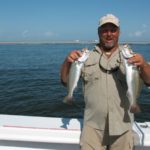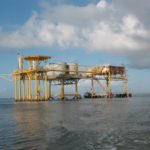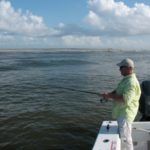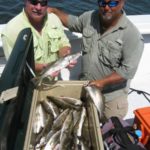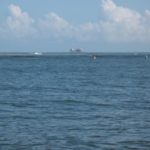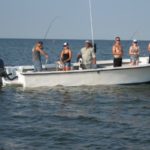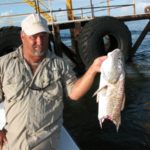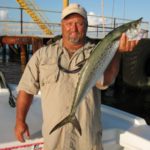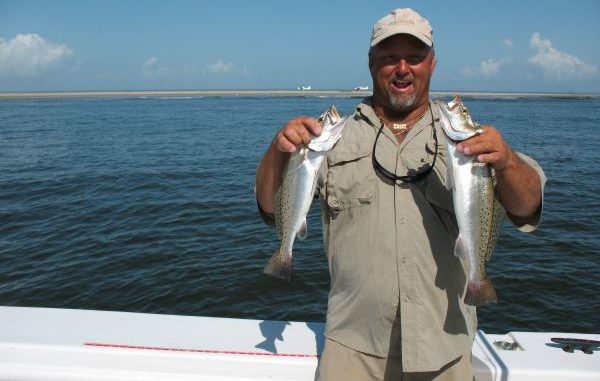
Resist the urge to stop at hotspots along the way and you’ll be glad you make the long haul to Breton Sound this month.
I’d talked about taking this trip for months and now, finally, I was on my way.
I was seated beside Capt. Casey Kieff (504-512-7171) in his 25-foot C-Hawk, which was cutting a meandering route through Hopedale’s China Pass, Halfmoon Lake and Lake Eloi en route to the deep sound.
Our destination: Breton Island, Gosier Island and the numerous rigs and platforms on that end of Breton Sound.
We left out of Shell Beach before daylight with a baitwell loaded with live shrimp and a determination not to get sidetracked.
You see, I’ve attempted to make this run before. In fact, on several occasions I left the dock with every intention of running all the way to Breton Island without stopping along the way.
The temptation is to talk yourself out of making the long run out there and back. I would begin to reason with myself: “Why run so far and burn so much fuel when you can stop and find fish in so many places along the way?”
Then I’d see boats catching fish at the rocks along the MRGO or at the rigs in Bay Eloi, and I’d succumb to the temptation to pull over and try fishing there, too.
As set and determined as I was to go all the way outside into the deep sound, I talked myself out of it every time.
I admit it, I’m weak.
But, I determined this time would be different. This time, I would not be distracted. This time, come waves, winds, birds diving or more boats lined up along the rocks than at the boat show, I wasn’t stopping until I was within sight of the barrier islands.
And this time, I had planned for success. This time, I wasn’t piloting my boat but was a passenger in Kieff’s vessel, and I’d given him clear instructions not to stop until we were at Breton Island, no matter how much I whined or how logically I reasoned or how convincingly I suggested an alternate plan.
This trip was Breton or bust!
And Kieff’s twin Yamaha 150s droned in the early morning air and steadily pushed the big C-Hawk toward our destination.
Breton Island itself is similar to other islands where a vast variety of coastal birds nest, in that you smell the island almost as soon as you actually see it if you approach from downwind. The pungent odor of such places is unmistakable, and once you get a whiff of it you never forget it.
But Kieff didn’t stop at Breton Island. Instead, he kept the bow pointed south and steered directly toward some big, yellow rigs a couple miles past Breton.
“That’s where we’re going to start today,” he said, pointing at the largest of several yellow rigs in Block 53.
I soon learned that Block 53 consists of several rigs, four or five in all, and all are painted yellow. The rigs, while two or three miles past Breton Island, are still in state waters, so redfish caught there are legal to keep.
Kieff says the state line ends just south of the rigs and federal waters begin behind them. All redfish caught in federal waters are illegal to keep.
Kieff had recently made a trip out to this rig and took home a box of big trout to show for it, so he figured we’d start our day there and hope for a repeat performance.
Kieff had also invited a long-time friend along with us: Picayune Fire Department Battalion Chief Darren Dennis, who wasted no time getting a line in the water.
The water was about 14 feet deep, so we fished with bottom rigs, either sliding sinkers or drop-shot rigs loaded with live shrimp.
And it didn’t take long for the action to start.
The old saying, “First line in the water is the first to catch a fish” held true, and Dennis soon landed a hefty black drum. It wasn’t what we were looking for, but it got us off to a good start, and within minutes we had more big tugs on our lines.
In rapid succession, we caught redfish, sheepshead, a nice-sized Spanish mackerel, a small cobia, a small mangrove snapper and more black drum.
We also caught some nice-sized jacks and had line break off from super-sized specimens, probably either jacks or sharks. Kieff said he’s caught quite a variety of fish — including pompano and red snapper — over the years at these structures and the Central rigs.
The action was steady, but the big trout we hoped for were entirely absent. We debated moving when I hooked into a nice-sized redfish and struggled to get him to the boat. Kieff stood by with the landing net, and just when I tired the big fish out enough to reel him toward the net, a big, sleek shark flashed beside the boat and bit my redfish in half.
That’s when we decided to move.
Kieff said all of the Block 53 rigs are worth trying, particularly the bigger rigs.
“It’s common sense that the bigger rig provides more structure in the water, and that attracts more fish,” he said. “It’s not that the smaller satellite structures won’t have fish, too, but the odds increase at bigger structures.
“The key out here is to look for clean water and bounce around until you find fish.”
Next stop: Breton Island
Breton Island is still impressive, though only a shadow of her pre-Katrina self. The banana-shaped island is a major nesting ground for coastal birds and is off limits, so camping or even walking on the island is prohibited. But you can still wade around the island if you stay in the water and don’t walk on the island itself.
Kieff says the island can be tough to fish from a boat because of the sandbars that extend out a good way, quickly evidenced by the breaking waves.
The key and the challenge, he said, is to anchor as close to the outer sandbar as possible without drifting aground upon it.
Then cast as far as you can over that sandbar into the trench between it and the sandbar closer to the beach.
“That’s where the fish are,” he said.
We anchored just ahead of the outer sandbar and made some casts toward the trough. We fished live shrimp on sliding-sinker rigs, the typical technique for the area, but with little success. We made a move and anchored again a little farther down and managed to catch a couple of decent trout, but the action was very slow. Despite the slow bite, I enjoyed the scenery so much that I was reluctant to leave.
But Kieff had another stop in mind and was eager to explore, so off we went.
Grand Gosier
Gosier Island is about a 10-mile run from Breton Island, and both islands are part of the Breton Island National Wildlife Refuge.
Two seaplanes and a couple of boats were anchored on the lee side of the island when we arrived, and eight or 10 anglers were spread out and wade fishing in the surf.
Kieff said Gosier was actually easier to fish from a boat than Breton Island because both the Gulf side and the sound side are more approachable.
We anchored on the surf side, started enticing the fish with our live shrimp on sliding-sinker rigs, and were quickly rewarded.
The trout were there, and they were hungry.
The action was fast and furious, with almost every cast getting a good hookup.
After a while, I got tired of rebaiting and started throwing plastic, and the fish slammed it just as quickly. I was trying a new bait by Deadly Dudley in “fools gold,” a gold flake/clear color and a chartreuse tail, on a ¼-ounce plain jig — and the trout ate it up.
Kieff broke out his baitcaster rig, tied one on also and had the same result.
Over the course of the next hour, we consistently caught fish. At times it would slack off a bit and we’d all switch back to live shrimp, and soon the action started up again.
Almost everything we tossed met with success — live shrimp under a cork or on the bottom; and soft plastics in gold flake, clear, glow, black/white, avocado — and we soon had our three-man limit.
I really think when they’re worked up into a feeding frenzy like that, they’ll hit almost anything.
“You have so many options out here,” Kieff said. “Four miles from here to the northwest is what we call the Central Field, which includes several big satellite rigs. Besides the big rig (Central itself), there’s No. 28, 29, 21 and 22 near it. Those are the bigger structures and the ones you want to fish.
“Like I said, bigger structures are like a bigger reef: They provide bigger forage for the fish and better opportunities for anglers to catch fish.”
The approach to fishing these larger facilities is a bit different than when probing the smaller structures, he said.
“At the big rigs, you want to hook on close to the rig with your rig hook, and then fish on the bottom,” Kieff said. “At the smaller satellite rigs, you can also try anchoring upcurrent and casting toward the rig.
“Just be sure to bring plenty tackle when you fish around these rigs because the bottom is littered with pipes and cables and debris, and you are going to lose some tackle. Some anglers like to fish sliding-cork rigs out here because the bottom keeps grabbing all their tackle.”
Kieff also suggested spooling up your reel with 30-pound braided line when fishing the rigs.
“You know there are some big fish out here — bull reds and drum, big sheepshead and trout, Spanish mackerel, jacks, sharks and a variety of other species — that will bite through light line or break it off against the rigs,” he said.
Kieff said the best plan of action is to get a very early start and head straight to the islands.
“Fish the islands first in the early morning before the sun warms things up too much,” he said. “The fish will usually hang real close to the islands early; then they’ll steadily move farther off the islands as it warms up.”
Successful anglers simply follow the trout out.
“Fish the sandbar nearest to the island early, then the second sandbar later,” Kieff said. “Then they head to deeper, cooler water as the heat gets up.
“By mid-to late morning you’ll want to head to the rigs and fish the bottom or near bottom.”
Kieff should know the best strategy for fishing the deep sound because he has long experience at it: For nearly 10 years he worked off the Islander houseboat that was a standard feature of the Breton Islands in the days before Hurricane Katrina.
Then he chartered from a dive boat in the sound for another 7 or 8 years, so fishing the various islands and rigs in the region are common fare.
“Our biggest challenge out here is the wind. If we get a strong, steady west wind, you can forget it,” he said. “The water will be dirty and you’ll have a hard time catching trout, so I’ll fish somewhere else. Or if the wind is strong and steady from any direction, you might want to reconsider making the long run out there.
“Winds over 15 mph are a no-go for me. It’s not that the fish won’t be there, but I don’t want to take the pounding to get to them.”
So he waits for less-choppy days to make his long runs.
“If the winds are 8 to 15 (mph), I’ll go — even if it’s from the west, as long as it wasn’t blowing harder from the west the day before,” Kieff said. “You have to give it a chance to settle.”
And Kieff says wherever you fish, whether at the islands or the rigs, give each spot about 15 minutes to produce.
“If you don’t have any fish in the boat after 15 minutes, move,” he said. “And keep moving until you find them.
“If a spot plays out and you go 15 minutes without a bite, move again. There are fish out there, and plenty of them. Your job is to find them.”
You can reach Capt. Casey Kieff at 504-512-7171.
GPS Coordinates
Breton Island
According to our own Capt. Paul Titus, “The northern part of the island is called North Point, and the southern is called West Point. The radio tower on the north part of the island is located at or about N29 29.726 x W089 10.486. The western point of the southern section is about 3 miles to the southwest area at or about N29 27.864 x W089 12.586.
“The banana-shaped island once extended between these two points in a shallow “C” facing the west. My point in making this statement is to caution you when approaching this area,” he said.
Grand Gosier
According to Titus, Grand Gosier island is located at or about N29 33.582 x W89 03.395 and another is at or about N29 32.012 x W89 05.083. These parts of Grand Gosier are nearly on a straight line course from the North Point on Breton Island.
Central
“The Central Rig is one of about eight platforms of the Kerr-McGee series of rigs in the area north of the MRGO,” said Titus. “It is north of the MRGO, about 5 miles directly north of red No. 22 buoy in the MRGO channel.
“It is about 3.8 miles northwest of the Gosier Islands and is about 6.5 miles north-northeast of North Point Island of the Breton Islands, which are south of the MRGO.
“The Central rig, KM-BS-SL-1998-56, is located at or about N29 34.692 x W89 07.034. It is about 39 miles from Hopedale’s Breton Sound Marina, and is in the southern part of Breton Sound Leased Block 21, which is north of the MRGO.”
Destination Information
MARINAS — The deep sound is accessible from several launch sites on both sides of the river. From the east bank, Beshel’s Boat Launch in Pointe a la Hache (504-333-4469); Breton Sound Marina in Hopedale (504-676-1252) and Campo’s Marina in Shell Beach (504-239-6377). From the west side, Venice Marina (504-534-9357); Cypress Cove (504-534-9289) in Venice and Delta Marina (504-657-5116) in Empire.
MAPS — NOAA Chart 11363/Chandeleur and Breton Sounds.
For more Breton Sound locations…
Visit the online Sportsman Store to order Capt. Paul’s Fishing EDGE for Breton Sound, which is packed more than 305 GPS waypoints to popular fishing
desitnations.
Just log into http://www.shop.lasmag.com/ and click on “The Fishing EDGE” link.
